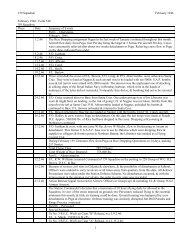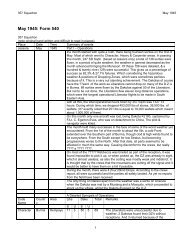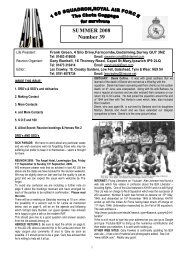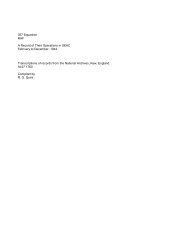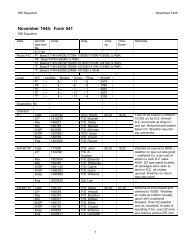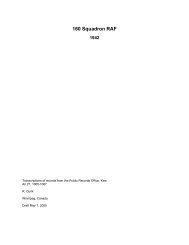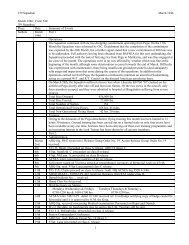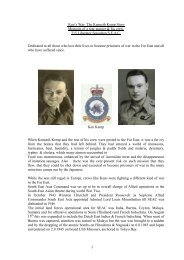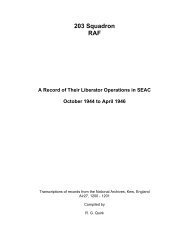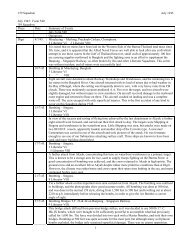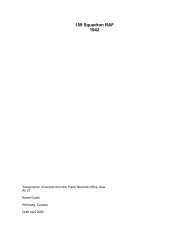RCAF Radar Personnel in WWII -North Atlantic Region-
RCAF Radar Personnel in WWII -North Atlantic Region-
RCAF Radar Personnel in WWII -North Atlantic Region-
You also want an ePaper? Increase the reach of your titles
YUMPU automatically turns print PDFs into web optimized ePapers that Google loves.
<strong>North</strong> <strong>Atlantic</strong> <strong>Region</strong><br />
W<strong>in</strong>ter weather came to be a bit monotonous - ‘snow and w<strong>in</strong>d’ alternat<strong>in</strong>g with ‘ra<strong>in</strong> and w<strong>in</strong>d’.<br />
Spirits were raised when word leaked out that “ . . .the Americans are com<strong>in</strong>g so we can go home<br />
. . .” The TRU’s ‘fixed aerials and goniometer’ system <strong>in</strong>itially bemused the US Signal Corps<br />
officers, radar techs and radar operators who arrived <strong>in</strong> early 1942 to man the station, as provided<br />
by the terms of the UK-US treaty mentioned earlier. Sometime <strong>in</strong> April, ‘RAF Olfus’ became<br />
‘Camp Hughes.’ Similar take-overs took place at Vik, and at the COL near Reykjavik; by mid-1942<br />
the <strong>RCAF</strong> radar presence <strong>in</strong> Iceland was entirely ‘Air.’<br />
<strong>RCAF</strong> <strong>Radar</strong> (Air) <strong>Personnel</strong> <strong>in</strong> the <strong>North</strong> <strong>Atlantic</strong><br />
Air operations <strong>in</strong> the <strong>North</strong> <strong>Atlantic</strong> dur<strong>in</strong>g <strong>WWII</strong> were primarily anti-submar<strong>in</strong>e and<br />
meteorological; no fighter, bomber or transport squadrons of either <strong>RCAF</strong> or RAF were based there.<br />
So the work of <strong>RCAF</strong> <strong>Radar</strong> (Air) personnel <strong>in</strong> that region was essentially that of ma<strong>in</strong>ta<strong>in</strong><strong>in</strong>g radar<br />
gear carried by RAF/<strong>RCAF</strong> Coastal squadrons fly<strong>in</strong>g Hudsons, Liberators and Cansos.<br />
An account written by David Roumieu of Smithers, BC, who served on RAF Sqd.86 based at<br />
Reykjavik, Iceland, <strong>in</strong> 1944, <strong>in</strong>cludes reference to earlier service at Aldergrove, <strong>North</strong>ern Ireland,<br />
where he was assigned to the Base <strong>Radar</strong> Section staffed by radar mechs from two RAF squadrons<br />
(86 and 59). David noted that the section was “ . . .95 percent Canadian . . .” This very high ratio,<br />
<strong>RCAF</strong> to RAF, was unusual, but it was a fact that RAF squadrons everywhere came to rely heavily<br />
on <strong>RCAF</strong> radar mechs(air); ground radar which, <strong>in</strong> the UK, expanded earlier than did airborne radar,<br />
had nearly exhausted the supply of UK recruits possess<strong>in</strong>g the qualifications for ma<strong>in</strong>ta<strong>in</strong><strong>in</strong>g airborne<br />
radar which was brought <strong>in</strong>to service later.<br />
E.V. (Bud) MacLachlan, of Ingersol, Ont, served on <strong>RCAF</strong> Sqd.162 based at Reykjavik from Jan.<br />
1944, onward. He wrote of meet<strong>in</strong>g Canadians there, serv<strong>in</strong>g on RAF squadrons, who “ . . .were<br />
glad to see a Canadian squadron arrive . . ..” He also mentions (with obvious pride) that his<br />
squadron received credit for 5 and a half ‘sub-s<strong>in</strong>k<strong>in</strong>gs’, that it was the first squadron to photograph<br />
a U-boat Snorkel, and that one of the pilots won a VC.<br />
Some <strong>RCAF</strong> radar mechs (air) drew ‘ground duties.’ Bill James, of Barrie Ont, ma<strong>in</strong>ta<strong>in</strong>ed a radar<br />
beacon used as a land<strong>in</strong>g aid by his squadron when based at Benbecula <strong>in</strong> the Outer Hebrides;<br />
apparently he felt lonely - he was the only mech. and the only Canadian there! Another Canuck,<br />
Warren Guscott of Kle<strong>in</strong>burg, Ont. was assigned to RAF Sqd.519, a meteorological unit based at<br />
Wick, Scotland, fly<strong>in</strong>g sorties up the coast of Norway, west to Iceland and back to Scotland.<br />
Warren’s ground chores - ma<strong>in</strong>ta<strong>in</strong><strong>in</strong>g radar nav beacons - carried a bonus: it <strong>in</strong>volved a pleasant<br />
drive across moors and highlands with stops at crofters’ homes to buy real hens’ eggs ‘<strong>in</strong> the shell.’<br />
These, Warren reported, “ . . .were very popular when we went south on leave - almost as good as<br />
silk stock<strong>in</strong>gs . . .”<br />
IV-13




